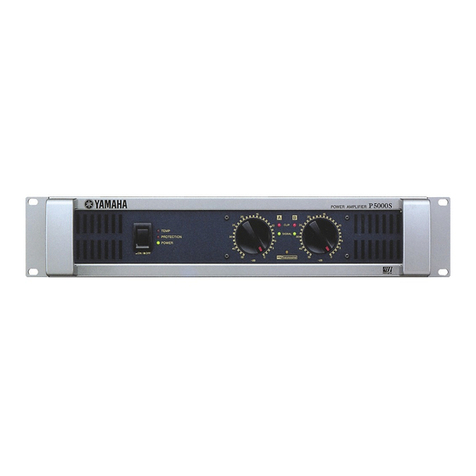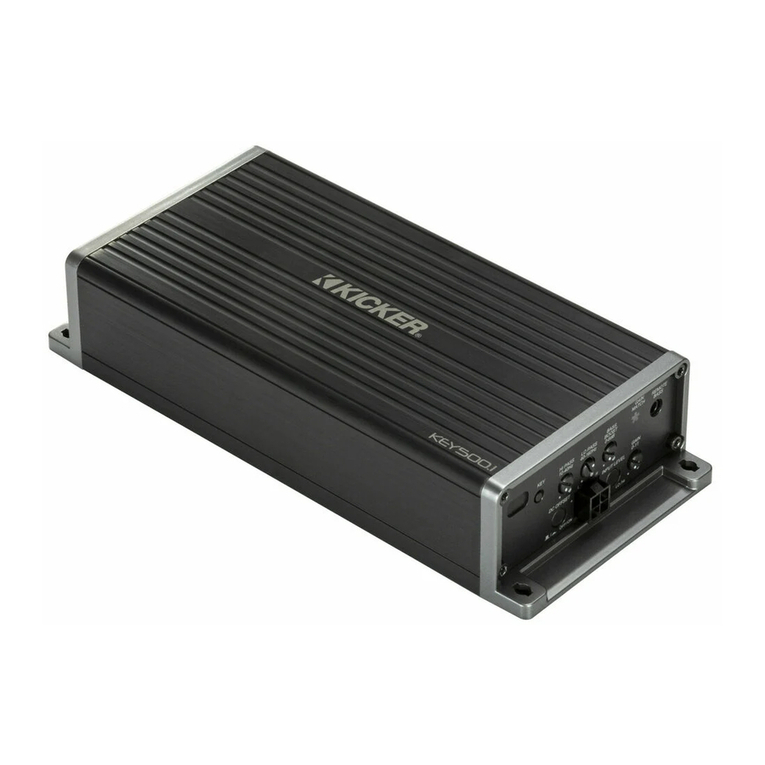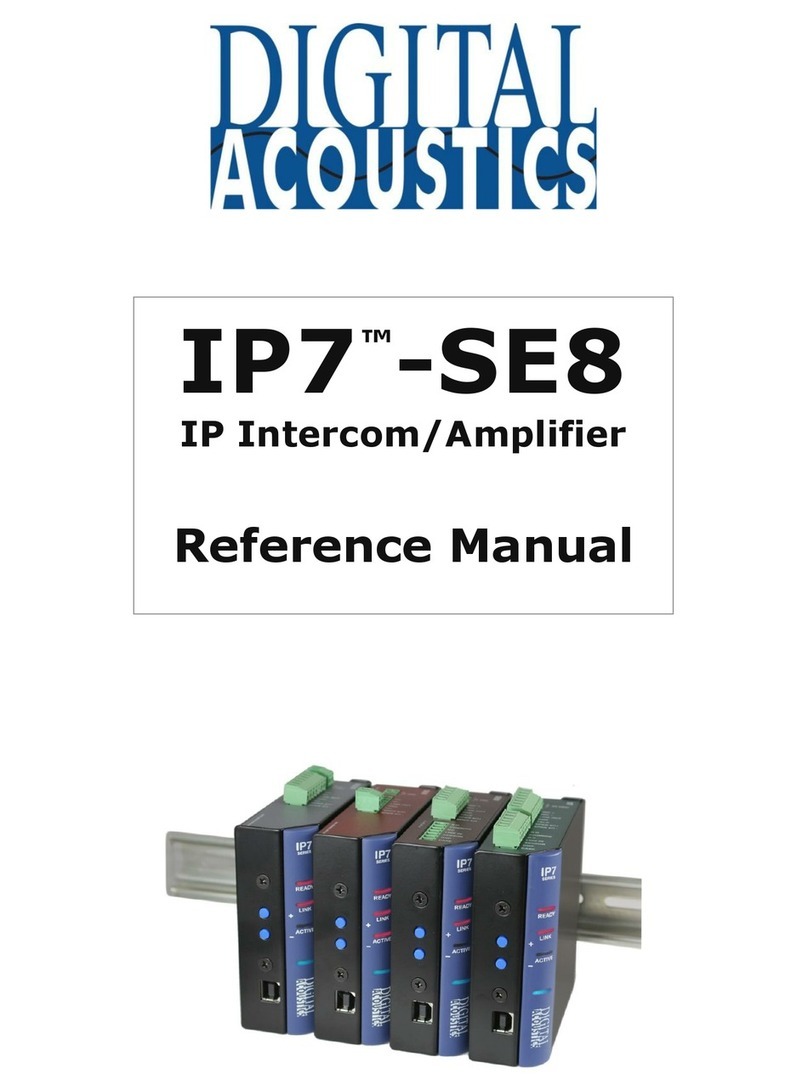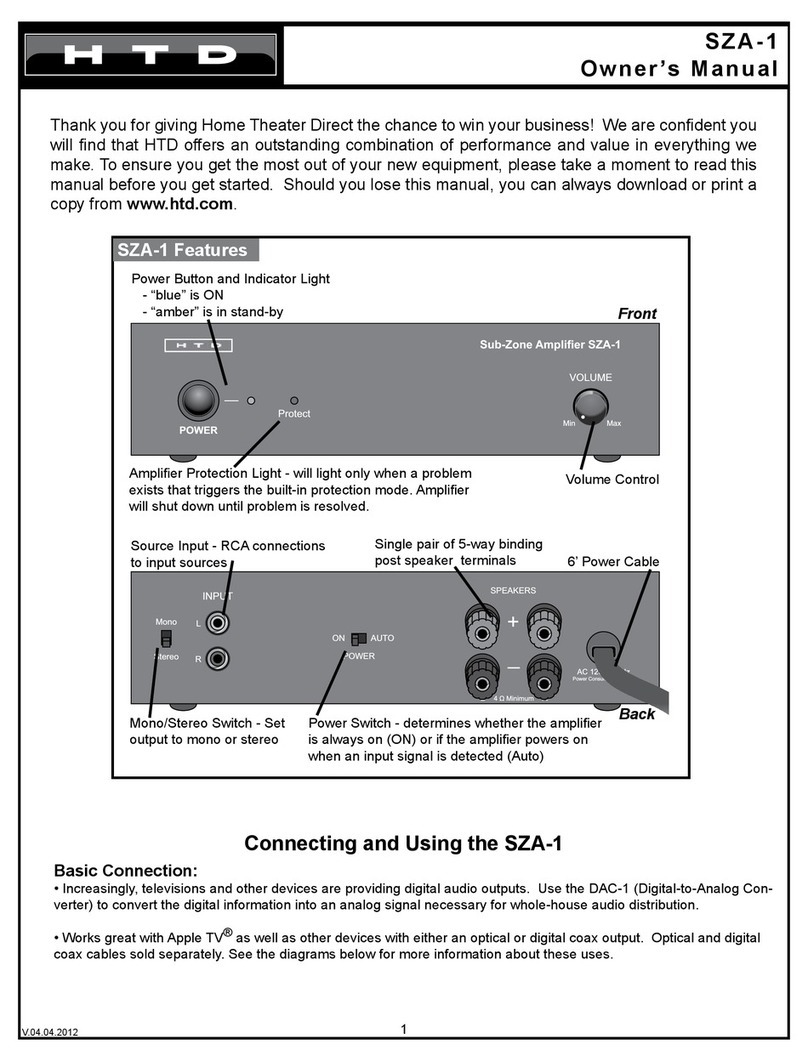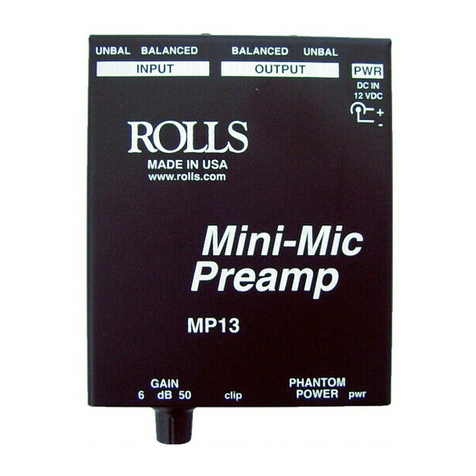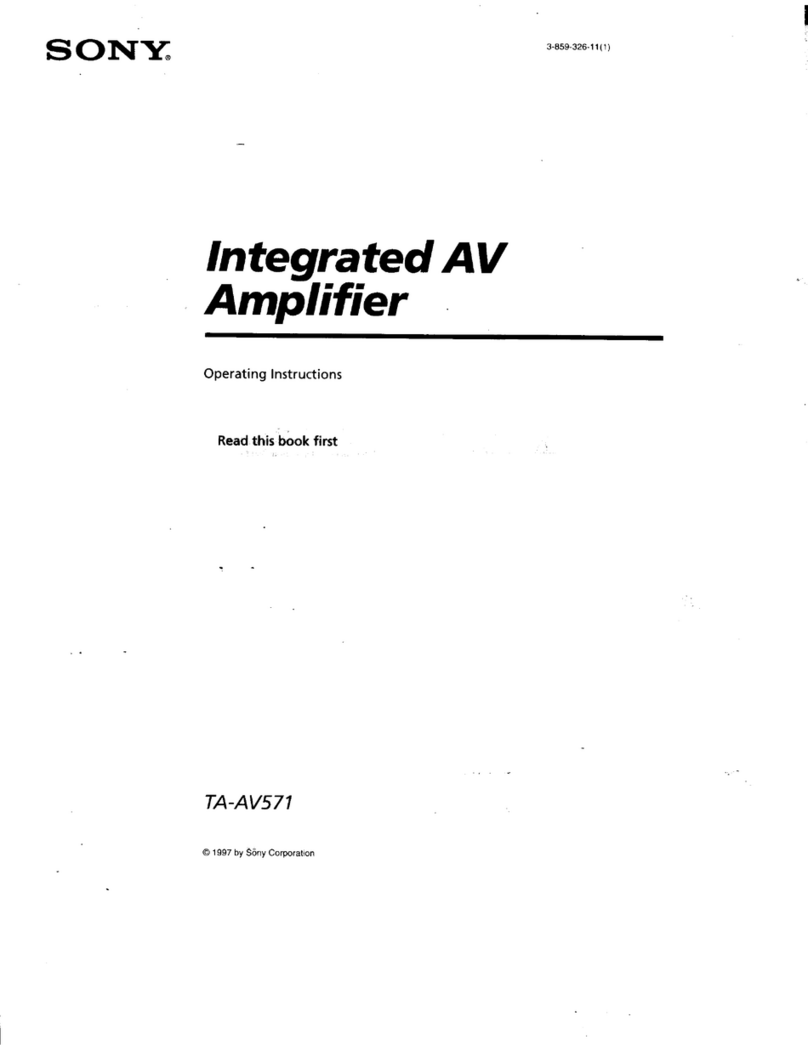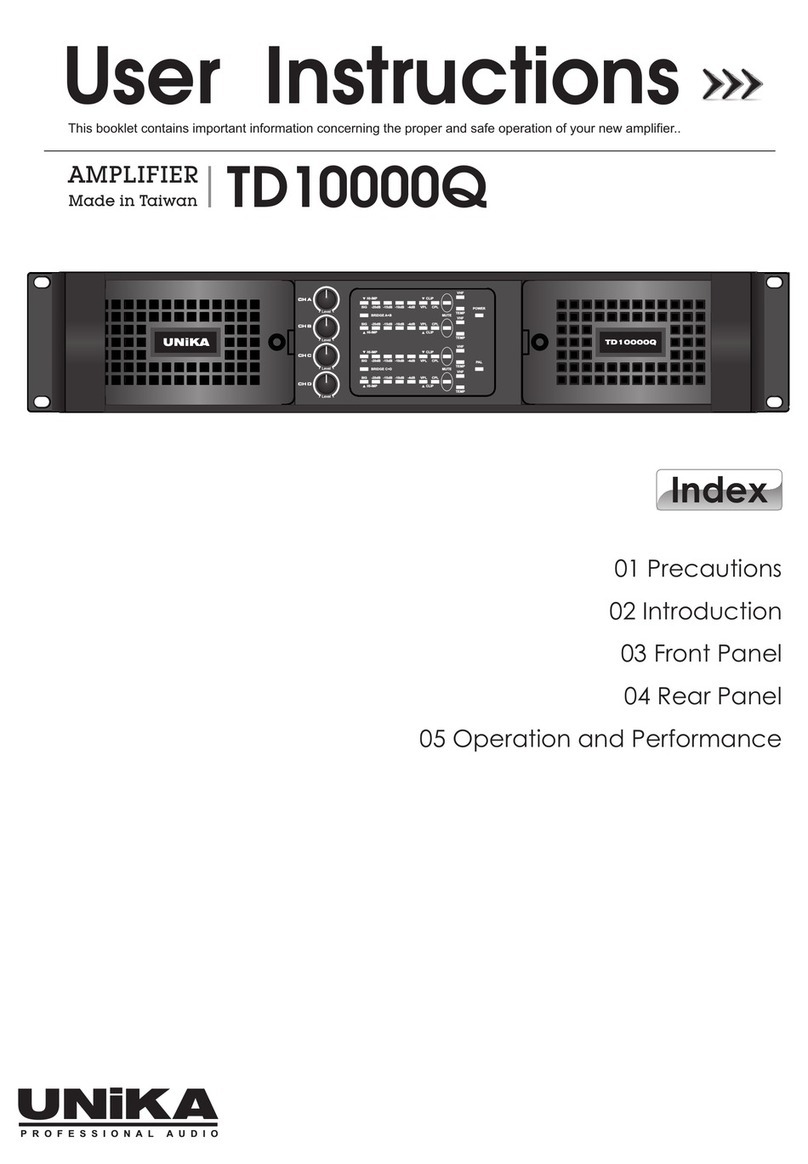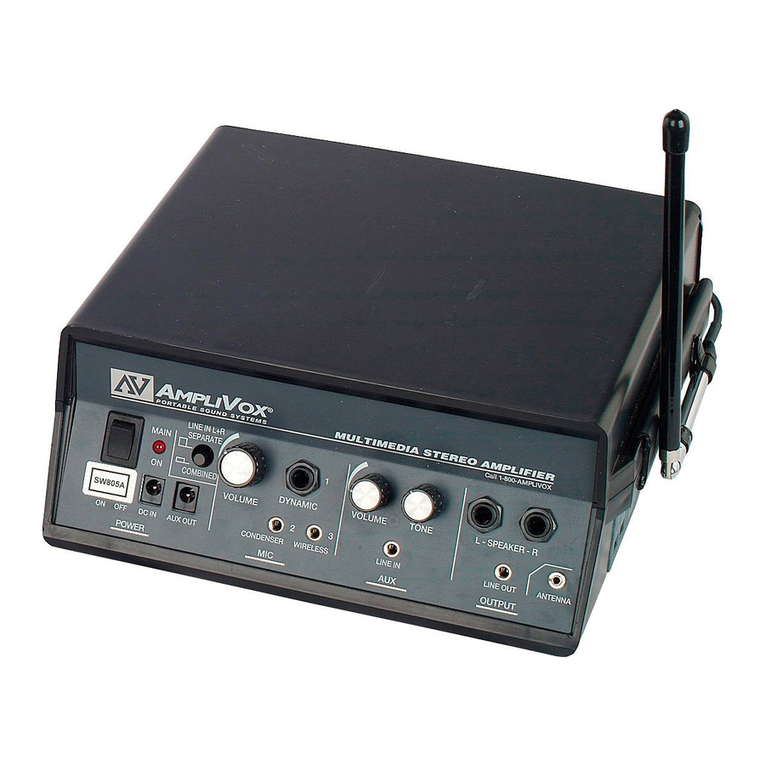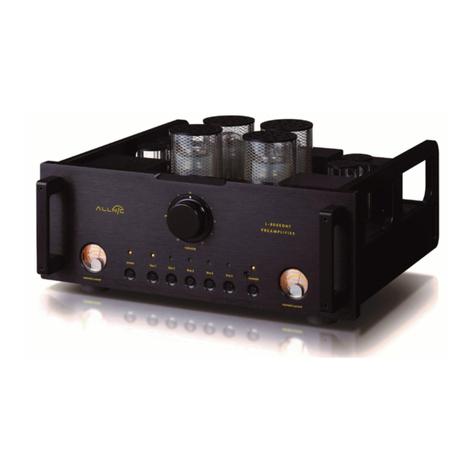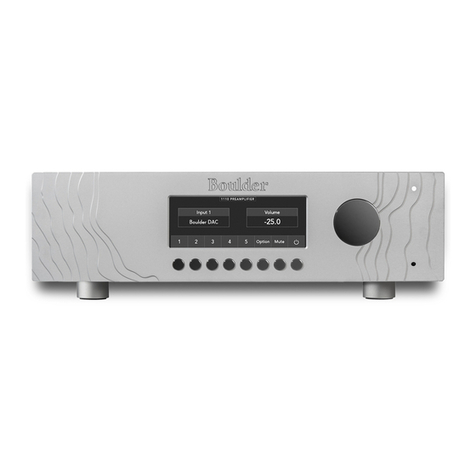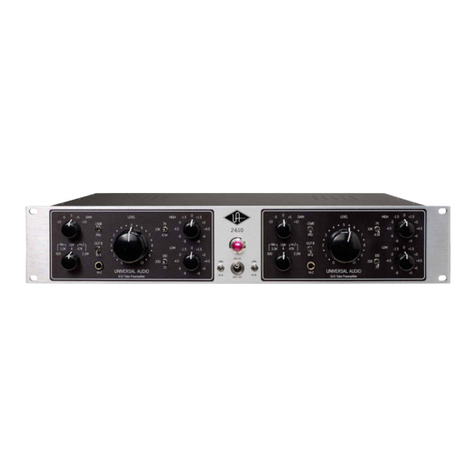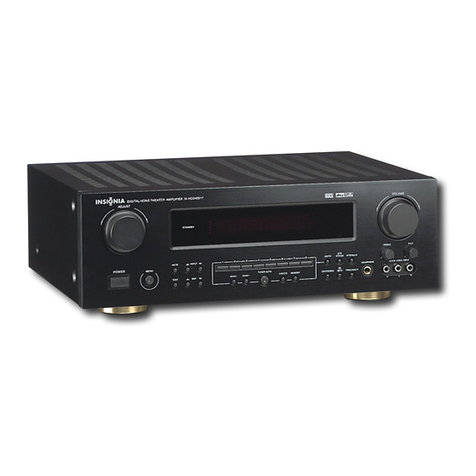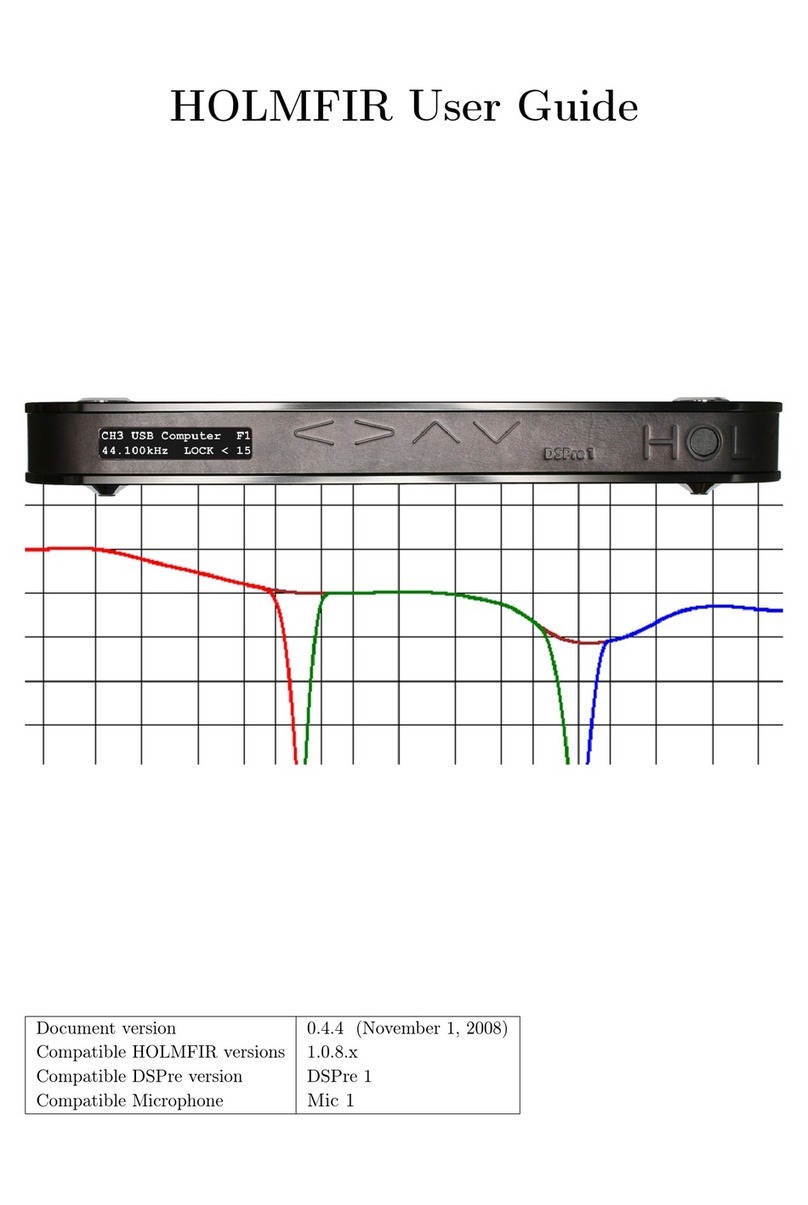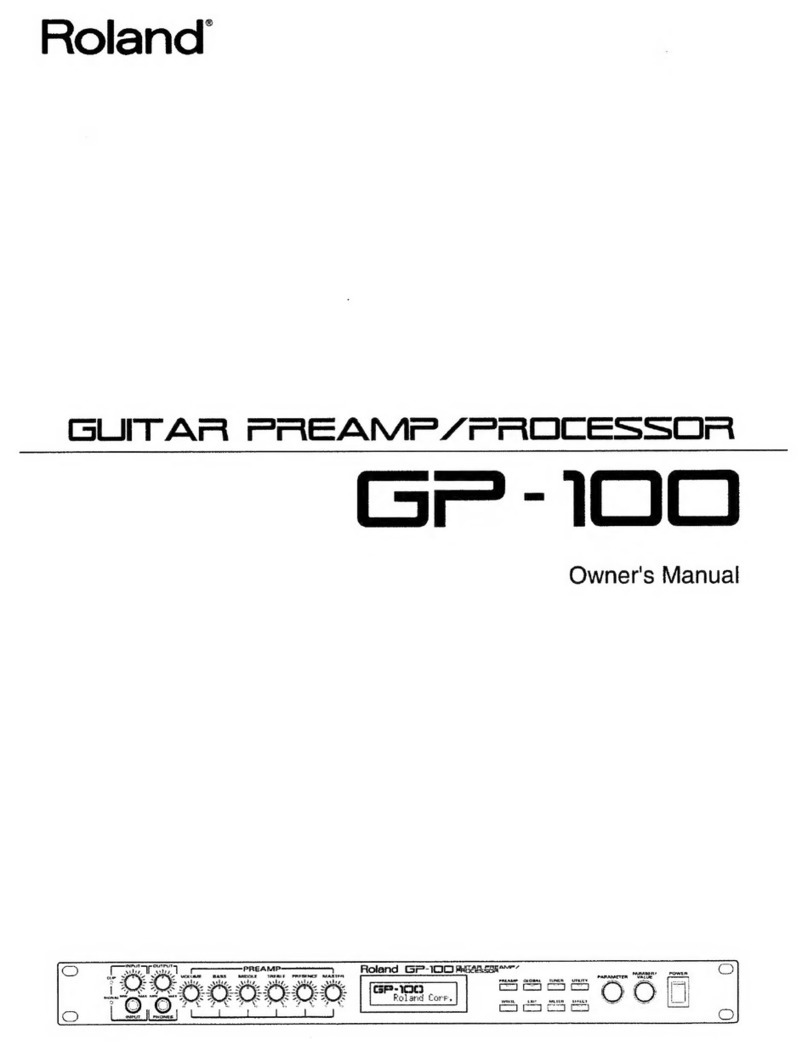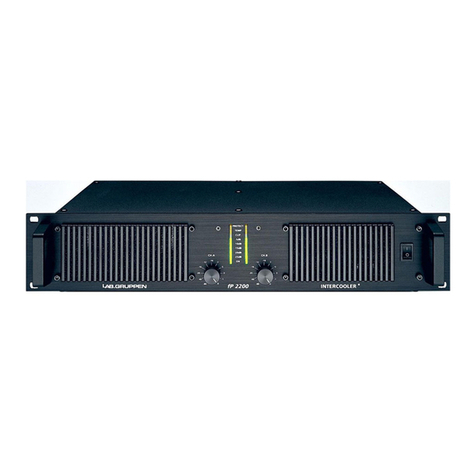Clark Synthesis TACTILE SOUND TA0.1 User manual

Owner’s Manual
TA0.1 Amplier with Wired Remote
Company Overview
Warranty
Safety Instructions
Product Introduction
Unpacking Your Amplier
Product Overview
Setting Up Your Amplier
Operating Your Amplier
Specications
Troubleshooting
Glossary of Terms
Index
Contact Information
Table of Contents
NOTE: READ THIS MANUAL BEFORE
OPERATING THE AMPLIFIER. FAILURE
TO FOLLOW THE INSTRUCTIONS IN THIS
MANUAL MAY RESULT IN DAMAGE TO THE
AMPLIFIER AND/OR THE SOUND EQUIPMENT
BEING POWERED BY THE AMPLIFIER.
2
3
4
5
6
7
13
20
22
23
24
26
28
PROFESSIONAL
INSTALLERS:
QUICK SETUP
INSTRUCTIONS
ON PAGE 13!

www.clarksynthesis.com
TA0.1 Amplier
2
COMPANY OVERVIEW
Thank you for purchasing a Clark Synthesis Tactile Sound Amplier! We are condent this product will be a
welcome addition to your audio system.
For many years, Clark Synthesis has been providing Tactile Sound Transducers for use in home theaters,
listening rooms, outdoor decks, military simulators, theme park attractions, game chairs, professional music,
and swimming pools. With such a variety of products, it is likely that Clark Synthesis has the right type of
transducer for your application.
Because Clark Synthesis transducers require amplication to operate properly, we offer the TA0.1 amplier.
The TA0.1 is designed for a wide variety of uses, including home theater, professional music, and game
chair applications.
With a focus on providing complementary products that provide quality sound and professional-grade
performance, Clark Synthesis is committed to designing products that will take your audio experience to the
next level. We are glad you chose a Clark Synthesis TA0.1 amplier and we hope that you will experience
many years of listening enjoyment using our products.
The Clark Synthesis products shown below can be powered with the TA0.1 Amplier.
TST429 Platinum Transducer TST329 Gold Transducer
AW339 All-Weather Transducer
AQ339 Aquasonic
Underwater Speaker
TST239 Silver Transducer

TA0.1 Amplier 3
www.clarksynthesis.com
WARRANTY
United States Warranty and Return Policy
TA0.1 CLARK SYNTHESIS AMPLIFIER WARRANTY
Clark Synthesis, Inc. warranties the TA0.1 Amplier to be free from defects and workmanship under normal use for a period of two (2) years from date
of original purchase.
Should warranty service be necessary, Clark Synthesis, Inc. will (at its discretion) repair or replace the defective merchandise with equivalent
merchandise at no charge.
This warranty is valid for the original purchaser and is not extended to subsequent owners. Any applicable implied warranties are limited in duration to
a period of the express warranty as provided herein beginning with the date of the original purchase at retail, and no warranties, whether expressed or
implied, shall apply to this product thereafter. Some states do not allow limitations on implied warranties; therefore these exclusions may not apply to
you. This warranty gives you specic legal rights; however, you may have other rights that vary from state to state.
WHAT IS NOT COVERED
This warranty is valid only if the product is used for the purpose for which it was designed. It does not cover the following:
Damage caused by excessive heat•
Damage through negligence, misuse, accident, or abuse•
Damage caused by incorrectly connecting the amplier to an output device or an electrical source•
Freight damage•
Items repaired by an unauthorized repair facility•
Items purchased from unauthorized individuals or dealers•
Cost of shipping product to Clark Synthesis, Inc.•
Return shipping on non-defective items•
RETURN POLICY
New, unused items purchased from us may be returned within 7 days of the purchase date. Please note: Clark Synthesis will only accept returns
for items that are received in their original packaging, in undamaged and re-sellable (new) condition. Manuals, accessories, warranty cards, and
everything else that came with the unit must be included as well. If your return does not meet these conditions, you will be charged a 15% restocking
fee or have the merchandise returned to you at your expense. Non-defective merchandise can also be returned for a 15% restocking fee. Shipping
charges for all non-defective returns or exchanges are not refundable.
WHAT TO DO IF YOU NEED WARRANTY OR SERVICE
If it becomes necessary for you to return defective merchandise, call Clark Synthesis Customer Service at (800) 898-1945 and you will be given a
Return Authorization Number. Follow the instructions provided by our customer service staff, use suitable packing materials (preferably the original
shipping boxes), and make sure to write your Return Authorization Number on the outside of your box when sending your return to us. Orders that are
returned without an Return Authorization Number may be refused by our returns department! Remember to include a dated proof of purchase from
an authorized dealer. Return freight must be prepaid by the customer: items received freight collect will be refused. If the returned product is found to
contain a manufacturing defect not caused by the customer and a replacement product is sent to the customer, Clark Synthesis, Inc. will pay to ship
the replacement product to a domestic location (within the USA) via ground shipping methods. Costs associated with a) shipping replacement products
intended to replace defective merchandise not caused by a manufacturing defect, b) replacement products shipped outside the USA, or c) replacement
products shipped via shipping methods other than ground shipping will be paid for by the customer.
Make sure the following is included in your package:
• Product to be returned (repacked in original shipping containers)
• Return Authorization Number printed on the outside of the box
• Copy of original invoice with Return Authorization Number printed on it
INTERNATIONAL WARRANTY
Contact your International Clark Synthesis dealer or distributor concerning specic procedures for your country’s warranty policies.

www.clarksynthesis.com
TA0.1 Amplier
4
SAFETY INSTRUCTIONS
READ THESE INSTRUCTIONS.1.
KEEP THESE INSTRUCTIONS FOR FUTURE REFERENCE.2.
HEED ALL WARNINGS.3.
FOLLOW ALL INSTRUCTIONS.4.
DO NOT USE THIS AMPLIFIER NEAR WATER.5.
CLEAN ONLY WITH A DRY CLOTH.6.
DO NOT BLOCK ANY VENTILATION OPENINGS. INSTALL IN ACCORDANCE WITH THE7.
MANUFACTURER’S INSTRUCTIONS.
DO NOT INSTALL NEAR HEAT SOURCES SUCH AS RADIATORS, HEAT REGISTERS, STOVES, OR8.
OTHER EQUIPMENT.
DO NOT DEFEAT THE SAFETY PURPOSE OF THE POLARIZED OR GROUNDING TYPE PLUG-9. A
polarized plug has two blades, with one wider than the other. A grounding type plug has two blades and a third
grounding prong. The wide blade or the third prong is provided for your safety. If the provided plug does not t into
your outlet, consult an electrician for replacement of the obsolete outlet.
PROTECT THE POWER CORD FROM BEING WALKED ON OR PINCHED, PARTICULARLY AT THE10.
POINTS NEAREST THE OUTLET AND WHERE THE CORD ENTERS THE AMPLIFIER.
ONLY USE ATTACHMENTS OR ACCESSORIES SPECIFIED BY THE MANUFACTURER.11.
USE ONLY WITH A CART, STAND, TRIPOD, BRACKET, OR TABLE SPECIFIED BY THE12.
MANUFACTURER OR SOLD WITH THE AMPLIFIER. When a cart is used, use caution when moving the cart
to avoid damaging the amplier.
UNPLUG THE AMPLIFIER DURING LIGHTNING STORMS OR WHEN UNUSED FOR LONG13.
PERIODS OF TIME.
REFER ALL SERVICING TO QUALIFIED PERSONNEL.14. Servicing is required when the amplier has been
damaged in any way, such as the power supply cord has been damaged, liquid has been spilled/objects have fallen
into the amplier, the amplier has been exposed to rain or moisture, the amplier does not operate normally, or the
amplier has been dropped.
WARNING: TO REDUCE THE RISK OF FIRE OR ELECTRICAL SHOCK, DO NOT EXPOSE15.
THIS AMPLIFIER TO RAIN OR MOISTURE.
DO NOT EXPOSE TO DRIPPING OR SPLASHING. DO NOT PLACE OBJECTS FILLED WITH16.
LIQUID, SUCH AS VASES, ON THIS AMPLIFIER.
TO PREVENT ELECTRIC SHOCK, DO NOT REMOVE TOP OR BOTTOM COVERS. NO USER17.
SERVICABLE PARTS INSIDE. REFER SERVICING TO QUALIFIED SERVICE PERSONNEL.
TO COMPLETELY DISCONNECT THIS EQUIPMENT FROM THE AC MAINS, DISCONNECT THE18.
POWER SUPPLY CORD PLUG FROM THE AC RECEPTACLE. THE MAINS PLUG OF THE POWER
SUPPLY CORD SHALL REMAIN READILY OPERABLE.
THE EXCLAMATION POINT WITHIN THE EQUILATERAL TRIANGLE IS INTENDED19.
TO ALERT THE USER TO THE PRESENCE OF IMPORTANT OPERATING AND
MAINTENANCE INSTRUCTIONS.
THE LIGHTNING BOLT TRIANGLE IS INTENDED TO ALERT THE USER TO THE RISK20.
OF ELECTRIC SHOCK.
SPECIAL SAFTEY CONSIDERATION FOR THE AQUASONIC SWIMMING POOL21.
SPEAKER: WHEN USING THE TA0.1 AMPLIFIER WITH THE CLARK SYNTHESIS AQUASONIC
SWIMMING POOL SPEAKER, WE RECOMMEND THE FOLLOWING:
- The amplier must be plugged into a GFI-protected outlet.
- Use an isolation transformer. Contact Clark Synthesis for more information.
!
!

TA0.1 Amplier 5
www.clarksynthesis.com
PRODUCT INTRODUCTION
OVERVIEW OF THE AMPLIFIER
The TA0.1 amplier is designed exclusively for use with Clark Synthesis transducers. This amplier
incorporates the latest digital technology and provides features not available on many ampliers. Please read
this manual in its entirety so you can get the maximum enjoyment from your Clark Synthesis product(s).
USING THIS AMPLIFIER WITH A CLARK SYNTHESIS TRANSDUCER
The TA0.1 amplier works with all Clark Synthesis transducers. This manual outlines how to use this amplier
with our transducers.
CAUTION: This amplier is designed to provide power to one (1) transducer.
Please note, the TA0.1 can provide more continuous power than the transducer can handle. Why do we
do this? Special effects audio signals often contain peaks that require extra power to be delivered to the
transducer. This amplier will supply those peaks without damaging the transducer, providing you, the user,
with a true Tactile Sound experience.
FEATURES
The Clark Synthesis TA0.1 Amplier has the following features:
Class D design for powerful, clean sound•
All-metal cabinet with pre-drilled holes in mounting plate and remote control interface box.•
Crisp, clean, and compact body design•
Wired remote control for “in-chair” adjustments•
Built-in Crossover Control that enables control of the cutoff point from • 40 Hz to 400 Hz
Bypass control that disables the Crossover Control, allowing the amplier to reproduce full-frequency audio•
Front LED that indicates the amplier is connected to AC power•
• Auto/On saves power by turning the amplier stage on only when an audio signal is present
Powered • loop-through allows you to connect multiple ampliers together to a single audio source
Stereo inputs allow you to connect the amplier to multiple sources. The audio is automatically combined •
inside the amplier.
IEC-601 • Connector allows you to use a power cord other than the power cord supplied. This is especially
helpful if you live in a country that requires a different AC plug.
Amplier automatically runs on AC power from 100 to 240 VAC, 50/60 Hz•
The audio input section works with high-level and low-level line signals. This feature permits the amplier •
to work with studio-level and consumer-level audio signals
• 5-way binding posts for connecting the transducer wires
!

www.clarksynthesis.com
TA0.1 Amplier
6
UNPACKING YOUR AMPLIFIER
PACKAGE CONTENTS
Please remove the amplier and accessories from the carton. You should have the following:
(1) TA0.1 Amplier•
(1) Wired Remote Control•
(1) AC Power Cord•
(1) • Y Adapter Cable (Color may vary from the image shown here)
(1) Operating Manual•
CONTACT INFORMATION IF PARTS ARE MISSING
If you are missing any items, please contact Clark Synthesis at 1-800-898-1945.
We recommend that you save the original carton to use if you ever have to ship the amplier.
WARNING: Before you set up this amplier, make sure you read and observe the Important Safety
Instructions in this manual.
!

TA0.1 Amplier 7
www.clarksynthesis.com
PRODUCT OVERVIEW
AC Panel
VentilationRemote Control
Input/Output Panel
Vents

www.clarksynthesis.com
TA0.1 Amplier
8
PRODUCT OVERVIEW
Gain (Volume) Control
On/Auto/Off Switch
Power Indicator Light
Low Pass/Bypass
Switch
Crossover (X-Over) Control
Remote Control Overview

TA0.1 Amplier 9
www.clarksynthesis.com
PRODUCT OVERVIEW
Remote Control Overview
GAIN (VOLUME) CONTROL
The Gain (Volume) Control on the face of the TA0.1 amplier controls the degree to which the
input signal is amplied. The gain level, combined with the level of the input signal, determines
the actual volume output.
CROSSOVER (X-OVER) CONTROL
The Crossover Control on the face of the TA0.1 amplier controls the range of low-frequency
(bass) sound sent to the output device, i.e. transducer, speaker, etc. This control is only
functional when the Low Pass/Bypass Switch is in the “Low Pass” position. The range of low-
frequency sound controlled by this dial is 40 Hz to 400 Hz.
ON/AUTO/OFF SWITCH
The On/Auto/Off Switch allows the user to place the amplier into Auto On/Standby mode, On, or
Off.
When the switch is set to “Auto” and no input signal is received by the amplier, the amplier
stage will power down and go into Standby mode. Upon sensing an input signal, the amplier will
power on automatically. When set to “Auto,” insure the High/Low Input Switch is set to “Low.”
When the switch is set to “On,” the amplier will remain powered on, regardless of whether an
input signal is present or not.
When the switch is set to “Off,” the amplier will power off.
LOW PASS/BYPASS SWITCH
The Low Pass/Bypass Switch enables and disables the Crossover function and control dial of the
amplier. When the switch is in the “Low Pass” position, the amplier only passes low-frequency
sounds. When the switch is in the “Bypass” position, the amplier passes the full range of audio
frequencies.
POWER INDICATOR (LED)
The Power Indicator LED displays the power mode. If the LED is:
RED- The amplier is plugged into AC power and the On/Auto/Off Switch is switched to “On.” •
If the On/Auto/Off Switch is set to “Auto,” a red LED indicates no audio input signal has been
received by the amplier.
GREEN- The amplier is plugged into AC power and the On/Auto/Off Switch is switched to •
“On.” If the On/Auto/Off Switch is set to “Auto,” a green LED indicates an audio input signal is
being received by the amplier, or, if the On/Auto/Off Switch is set to “On,” the amplier is on.

www.clarksynthesis.com
TA0.1 Amplier
10
PRODUCT OVERVIEW
Audio Input/Output Connectors
Transducer
Connector
High/Low Input Signal Switch
Input/Output Panel Overview

TA0.1 Amplier 11
www.clarksynthesis.com
PRODUCT OVERVIEW
Input/Output Panel Overview
AUDIO INPUT/OUTPUT CONNECTORS
The Audio Input/Output Connectors accept standard RCA plugs. These connectors are split into
Left and Right channels, as indicated by L and R on the panel. The Left and Right sides each
have one Audio Out and one Audio IN.
HIGH/LOW INPUT SIGNAL SWITCH
The High/Low Switch allows the user to select the voltage level of the audio input source. For
example, if the input source is a standard home theater or stereo receiver, the switch should be
set to “High” (unless using the “Auto” setting). If the input source is an MP3 player or portable
CD player, or if you are running the amplier with the On/Auto/Off switch set to “Auto,” the switch
should be set to “Low.” For any other type of input source, begin by using the “High” setting. If
you are not receiving enough output, try the “Low” setting.
TRANSDUCER CONNECTOR
The Transducer Connector is used to connect the transducer to the amplier. This connector
uses 5-way binding posts, which allow for a variety of ways to connect the transducer wire (see
“Connecting the Transducer to the Amplier” on page 18).

www.clarksynthesis.com
TA0.1 Amplier
12
PRODUCT OVERVIEW
AC Panel Overview
Remote Control Wire Connector
AC Power Cord Connector
(IEC-601)
AC POWER CORD CONNECTOR (IEC-601)
The AC Power Cord Connector is an adaptable connector that allows users to connect
IEC-601 compatible AC cords to the amplier. This type of connector is especially
benecial for international compatibility. The connector also houses a fuse used to
protect the unit from surges.
REMOTE CONTROL WIRE CONNECTOR
The Remote Control Wire Connector is the receiving slot for the male plug of the wired
remote control. All adjustments made on the Remote Control Interface and transmitted
through this connector.

TA0.1 Amplier 13
www.clarksynthesis.com
The following instructions are a quick overview of the steps necessary to install your new
amplier. For more detailed instructions, please refer to the sections in the manual that are
referenced below.
Remove the amplier from its package (for package contents, see “Unpacking Your 1.
Amplier” on page 6).
Mount or place the amplier and the remote control interface on the desired surface. 2.
Insure the amplier has adequate ventilation (see “Placing/Mounting the Amplier” on
page 14).
Plug the wire from the Remote Control Interface into the back of the amplier.3.
Insure you have set the amplier to the following settings: 4.
• On/Auto/Off Switch is set to “Off”
• Gain (Volume) Control is set to “Min”
• High/Low Input Signal Switch is set to “High”
For more detail on these settings, including pictures, see “Initial Settings Prior to
Making Connections” on page 15.
Connect the audio input source to the amplier. Insure you are connecting to both the 5.
Left and Right Input Connectors (see “Connecting the Audio Source” on page 16).
Connect the transducer to the amplier (see “Connecting the Transducer to the 6.
Amplier” on page 18).
If you using multiple TA0.1 ampliers to run multiple transducers, connect the loop-7.
through connections using RCA cables (see “Using the Powered Loop-Through to Run
Multiple Transducers” on page 19).
Plug the AC Power Cord into the back of the amplier and into an electrical outlet.8.
Once connected, turn your system on and 9. balance the sound (see “Balancing the
Transducer with the Subwoofer” on page 20).
Your system is now ready for use.10.
SETTING UP YOUR AMPLIFIER
Quick Setup Instructions

www.clarksynthesis.com
TA0.1 Amplier
14
SETTING UP YOUR AMPLIFIER
The TA0.1 can be custom mounted for use in a variety of applications. By utilizing the pre-drilled holes
in the mounting plate and the Remote Control, the user can mount the amplier to almost any surface
that provides 1) access to the Remote Control, 2) access to the Input/Output Panel and the AC Panel, 3)
adequate ventilation for the amplier, and 4) the ability to remove the amplier or the Remote Control for
servicing should that become necessary.
CAUTION: Insure there are two (2) inches of clearance around the amplier. DO NOT block the
air vents. The amplier will overheat if it does not have adequate ventilation.
The following steps describe the process for mounting your TA0.1 amplier:
Determine where you want to mount/place the Remote Control.1.
Determine where you want to mount/place the amplier.2.
Holding the Remote Control in the position you determined in #1, extend the wire from the 3.
Remote Control Interface box to the amplier’s prospective location to determine if it can reach
the amplier without being overstretched or pinched in any way. If the wire cannot reach, or will be
overstretched/pinched, adjustments will need to be made in the mounting location(s).
Once an adequate location for the Remote Control and the amplier is found, attach the Remote 4.
Control using the pre-drilled holes in the corners of the box (see below). To avoid damaging the
box, use 5/8 inch or M8 size at washers.
Attach the amplier to the mounting surface using the holes in the mounting plate (see below).5.
Connect the wire from the Remote Control to the amplier and apply the initial settings described 6.
in the next section.
!
Placing/Mounting the Amplier

TA0.1 Amplier 15
www.clarksynthesis.com
SETTING UP YOUR AMPLIFIER
CAUTION: Before connecting any wires or input/output lines, insure all equipment is
off and no signals are being sent from the input device.
In order to reduce the chances of accidentally damaging the amplier or transducer, please set the
amplier controls to the safety positions described and shown below:
Set the • On/Auto/Off Switch to the “Off” position (see photo #1)
Set the • Gain (Volume) Control to “Min” (completely counter-clockwise, see photo #2)
Set the • Input Signal Switch on the back of the amplier to the “High” position (see photo #3)
Photo #3
Photo #1
Photo #2
!
Initial Settings Prior to Making Connections

www.clarksynthesis.com
TA0.1 Amplier
16
SETTING UP YOUR AMPLIFIER
HOME THEATER
There are several different ways to hook up your system in terms of which source material (signal)
is delivered to the amplier(s) and transducer(s). Since our inception, we have discovered that
approximately half of our customers prefer using the LFE/SUB signal with their transducers. The other
half prefer using the Right Front (RF) and Left Front (LF) signals. Additionally, there are a few people
who like to use multiple signals concurrently. In the following instructions, we provide you with general
diagrams for each of these hookup methods.
LFE/SUB Hookup
The LFE, SUB, or Subwoofer output is the signal that you send to the subwoofer.
If your receiver has only one LFE/SUB/Subwoofer output port, connect a “Y” adapter to that output.
This will allow you to split the signal between the transducer and the subwoofer. To do this properly,
connect your subwoofer to one side of the “Y” adapter. Connect the TA0.1 amplier to the other side
of the “Y” adapter. To reduce the amount of noise produced when using this signal, use another “Y”
adapter cable when connecting to the amplier. This will allow you to connect the signal into both the
Left and Right input connectors on the amplier.
L
R
OUT
LFE/SUB
IN
Y Adapter
To Input of
Powered
Subwoofer
Y Adapter
Subwoofer
Transducer
Transducer
Surround-Sound ReceiverTA0.1 Amplier
Transducer Output
–+
Connecting the Audio Source

TA0.1 Amplier 17
www.clarksynthesis.com
Right Front (RF) and Left Front (LF) Hookup
For this hookup, connect the RF and LF Pre-Amp Outputs to the TA0.1 amplier inputs.
NOTE: Not all receivers have Pre-Amp outputs for the Right Front and Left Front outputs. If you
have a question about your receiver’s outputs, please consult your owner’s manual or contact your
receiver’s manufacturer.
Multiple Signal Hookup
This conguration is a little more complicated. You will need a small mixer to make this work.
Connect the signals you want to use to the mixer input. Then, connect the mixer output to the TA0.1
amplier input using a “Y” adapter.
OUTPUT
LF
LF CENTER LFE/SUB
CH4CH3CH2CH1
Pre-Amp Audio Out
Pre-Amp Audio Out
RF
RF
Y Adapter
Transducer
Transducer
Surround-Sound Receiver
Surround-Sound Receiver
Mixer
TA0.1 Amplier
Transducer Output
Transducer Output
–
–
+
+
SETTING UP YOUR AMPLIFIER
L
L
R
R
OUT
OUT
IN
IN
TA0.1 Amplier
Transducer
Transducer

www.clarksynthesis.com
TA0.1 Amplier
18
SETTING UP YOUR AMPLIFIER
If you are able to locate the amplier within 3 feet of the transducer (3 ft. is the approximate length of
the speaker wire attached to the transducer), connect the transducer wires directly to the amplier. This
can be done by unscrewing the wire binding posts, inserting the wire through the hole in the post and
then retightening the binding posts (see photo on this page). To insure you have a secure connection,
make sure the insulation on the wire does not get pinched when tightening the cap on the binding post.
NOTE: The 5-Way binding posts can be connected to in several ways. You can insert banana plugs
into the end of the posts, insert pin connectors or bare wire through the hole in the post (as shown in
photo), wrap bare wire around the posts and tighten the post caps, or install lug terminals around the
posts.
If you are unable to locate the amplier within 3 feet of the transducer, you will need to splice the
speaker wire coming out of the transducer with another comparable wire of the correct length. Once
spliced, attach the ends of the added wire to the amplier as discussed above.
NOTE: Our general wire size recommendations for additional wire are as follows:
0 to 25 feet, 16 AWG
25 to 50 feet, 14 AWG
50 to 75 feet, 12 AWG
Connecting the Transducer to the Amplier

TA0.1 Amplier 19
www.clarksynthesis.com
SETTING UP YOUR AMPLIFIER
The TA0.1 has powered loop-through. This feature enables the user to take the signal from an audio
source and pass it to a series of TA0.1 ampliers in order to drive multiple transducers.
The drawing for this type of hookup is shown below. Use a standard “Y” adapter to get the signal from
the audio source (e.g., from the LFE/SUB output). If the input signal is coming from two ports (e.g.,
from the RF and LF outputs), the “Y” adapter is not needed. The wires from those connectors can be
connected directly to the “Audio In” connectors of the TA0.1.
Subsequent wiring between the ampliers can be done with single or paired wire connectors. The
wiring for the transducers is the same as that for a single transducer hookup (see “Connecting the
Transducer to the Amplier” on the previous page).
Transducer #3Transducer #2Transducer #1
Audio Source
TA0.1 Amplier #3TA0.1 Amplier #2TA0.1 Amplier #1
Transducer OutputTransducer OutputTransducer Output
––– +++
Using the Powered Loop-Through
to Run Multiple Transducers
L L L
R R R
OUT OUT OUT
IN IN IN

www.clarksynthesis.com
TA0.1 Amplier
20
OPERATING YOUR AMPLIFIER
For Home Theater installations, once you have properly set up your amplier, it is important to take time to
balance the transducer and subwoofer sound. The volume of the transducer is controlled by the receiver and
will rise or fall in direct proportion to that of the primary speakers. This proportion is determined by both the
volume setting on the receiver and the gain setting on the TA0.1 amplier.
NOTE: Some receivers have internal, automatic balancing systems. These systems rely on microphones
that sense the sound levels within the room. Since tactile sound transducers are heard through your body,
instead of through the air, automatic balancing systems may be ineffective when balancing the subwoofer
volume. We suggest using the following procedure, rather than activating the automatic balancing system.
STEPS:
Set the TA0.1 1. On/Auto/Off Switch to “OFF” (see photo #1 below).
If you are using a low-level signal, such as an MP3 player, set the 2. High/Low Switch to “LOW.” If you are
connecting to a high-level signal, such as an A/V receiver, set the switch to “HIGH.” (see photo #2).
Turn the 3. Gain Control counter-clockwise to the “MIN” position (see photo #3).
Balancing the Transducer with the Subwoofer
Photo #1
Photo #2
Photo #3
Other manuals for TACTILE SOUND TA0.1
4
Table of contents
Other Clark Synthesis Amplifier manuals

Clark Synthesis
Clark Synthesis TACTILE SOUND TA0.1 User manual
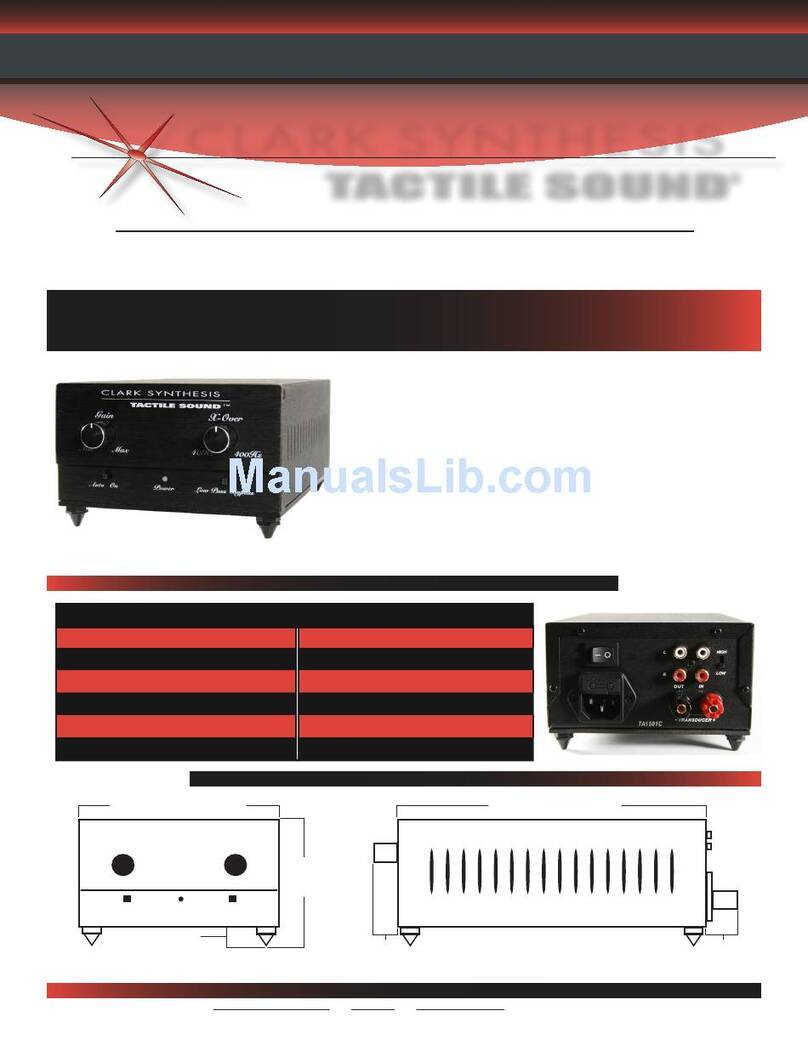
Clark Synthesis
Clark Synthesis TACTILE SOUND TA1501C User manual

Clark Synthesis
Clark Synthesis TACTILE SOUND TA0.1 Manual
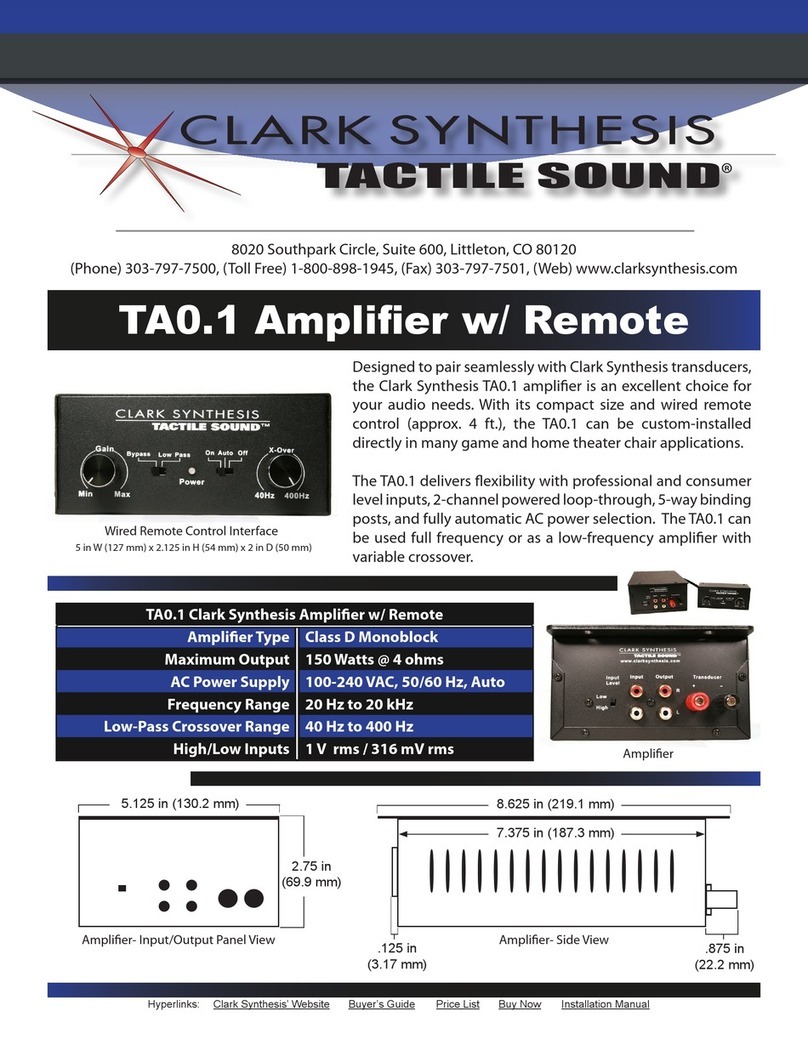
Clark Synthesis
Clark Synthesis TACTILE SOUND TA0.1 User manual
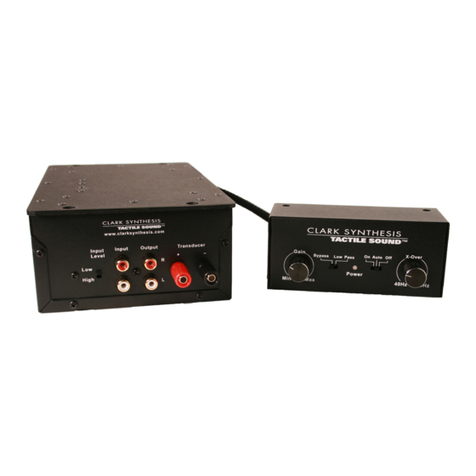
Clark Synthesis
Clark Synthesis TACTILE SOUND TA0.1 User manual
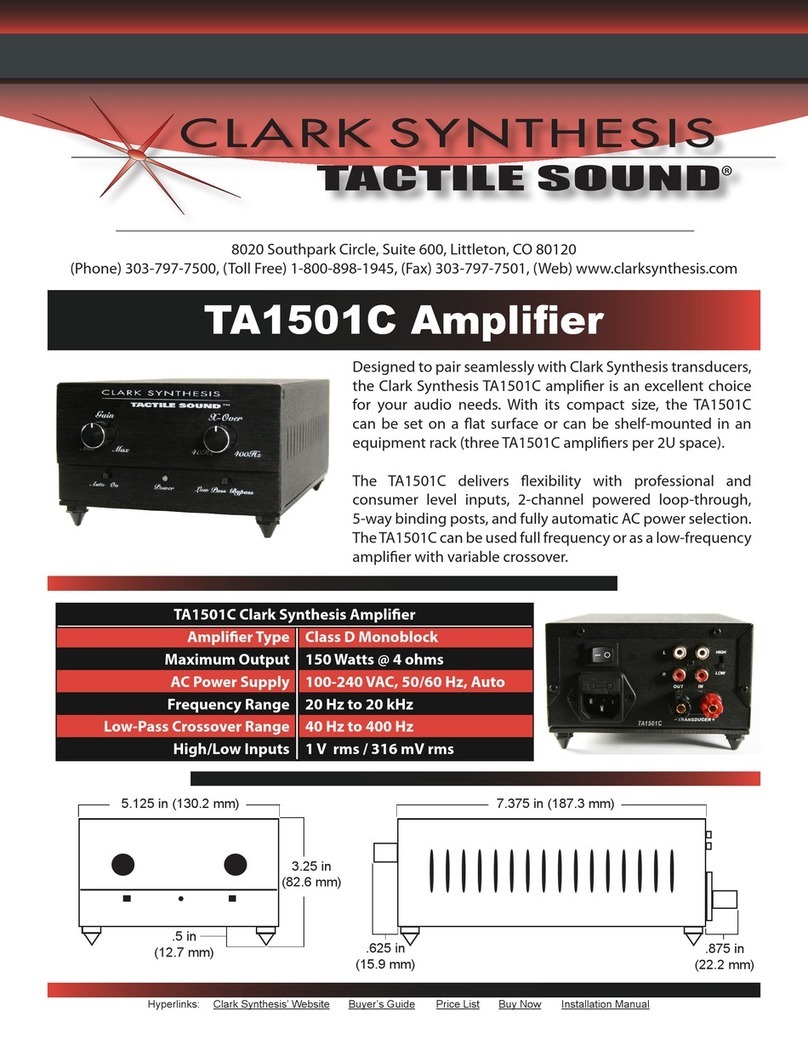
Clark Synthesis
Clark Synthesis TACTILE SOUND TA1501C User manual

Clark Synthesis
Clark Synthesis TACTILE SOUND TA1501C User manual
